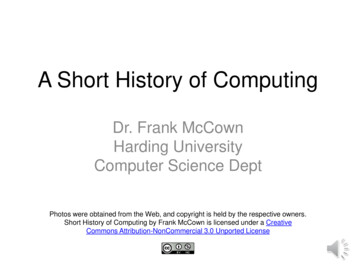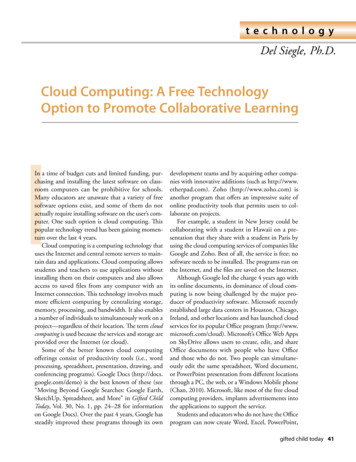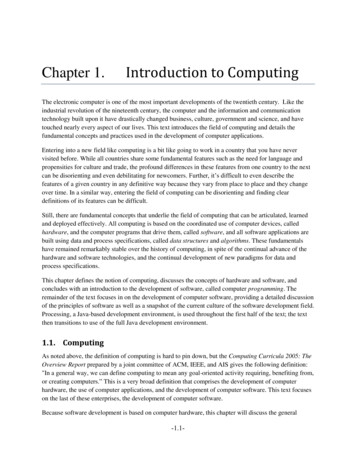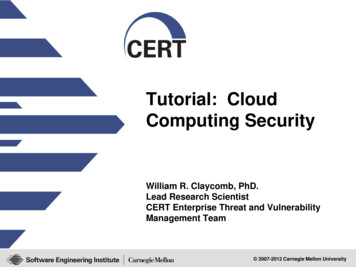
Transcription
A Short History of ComputingDr. Frank McCownHarding UniversityComputer Science DeptPhotos were obtained from the Web, and copyright is held by the respective owners.Short History of Computing by Frank McCown is licensed under a CreativeCommons Attribution-NonCommercial 3.0 Unported License
Fingers!Digit: Latin for fingersKid Snippets: "Math Class" (Imagined by Kids)http://www.youtube.com/watch?v KdxEAt91D7k
AbacusVarious forms dateback to 2300 BCAsian on.jpgRoman abacus
1600s: Mechanical Calculating Machines1642: Blaise Pascal’sPascaline1610: WilhelmSchickard’s calculatingmachine1694: GottfriedLeibniz’s mechanicalcalculatorPhotos courtesy of Wikipedia
1801: Jacquard LoomJoseph Jacquard invents loomthat is “programmed” usingpunched cardsMachines replacing humansgives rise to fears: During theIndustrial Revolution, Ludditesbroke into factories and millsand destroyed as manymachines as .loom.full.view.jpg
1860s: Babbage’s EnginesCharles Babbage invents (but never completely builds) two machines:1) Difference Engine – To solvepolynomial equations2) Analytical Engine – Generalpurpose machine, precursorto the ontent/uploads/2010/03/analytical engine.jpg
Mid 1800s: Ada LovelaceAda Lovelace, daughter of thepoet Lord Byron, worked withBabbage on the Analytical EngineProgrammed Analytical Engineusing punched cardsConsidered first computerprogrammerAda programming languagenamed after herhttp://en.wikipedia.org/wiki/File:Ada lovelace.jpg
1890: Hollerith’s Census MachinesHerman Hollerith developed amachine for tabulating UScensus which used punchedcards1880 census took 8 years totabulate1890 census took 1 yearHollerith’s Tabulating MachineCompany later became part ofIBMhttp://en.wikipedia.org/wiki/File:Hollerith punched card.jpg
1936: Turing MachineAlan Turing, considered thefather of computer science,described a theoretical devicecalled the Turing machine or“a-machine”. Formalized theconcepts of computation andalgorithmsTuring later helped crackGerman military codes duringWorld War IIhttp://en.wikipedia.org/wiki/File:Alan Turing .png
1939: Atanasoff-Berry ComputerJohn Atanasoff and CliffordBerry built the ABC at IowaState which found solutions tosystems of linear equationsConsidered first fullyelectronic digital computingdevice, but was notprogrammable or inventors/blatanasoff ff-Berry Computer at Durhum Center.jpg
Infamous Quotes“I think there is a worldmarket for maybe fivecomputers.”-Thomas Watson Senior, Chairman of IBM, in 1943This would remain true for 10 more years.
1944: Harvard Mark IHoward Aiken designsMark I, the firstoperational generalpurpose electromechanical computer.Financed and built at IBMOn display at Harvard rk1 harvard.jpg
1946: ENIACJohn Mauchley and PresperEckert complete the ElectronicNumerical Integrator andCalculator (ENIAC) at Univ ofPennsylvania. Much based onAtanasoff’s ABCFirst general purpose, digitalelectronic computerCould compute a ballistic firingtrajectory in 20 sec vs. 30 minconventional wayDimensions: 30 x 30 feetWeight: 30 tonsPowered by 18,000 .jpg
1947: Computer BugComputer operatorsworking with Grace MurrayHopper on Harvard’s MarkII computer discover a“bug”, a moth lodged in thecomponents, and paste itinto the computer’s logbookwhich now resides 566k.jpg
1947: TransistorBell Labs develops thetransistor (right), anelectronic switch made with asmall piece of silicon withadded impurities. It’s smaller,uses less power, morereliable, and cheaper toproduce than vacuum y rer (croped).jpg
1951: UNIVAC IUNIVersal Automatic ComputerI (UNIVAC I), designedprincipally by Eckert andMauchly, is the firstcommercially successfulcomputerPrice: 1.25M - 1.5MUnits Produced: 46Sweeney (left) and Eckert (center)demonstrate the U.S. Census Bureau'sUNIVAC for CBS reporter WalterCronkite (right).http://en.wikipedia.org/wiki/File:UNIVAC 1 demo.jpg
1954: FORTRANJohn Backus and IBMdevelop FORTRAN, the firstsuccessful high-levelprogramming language andcompilerDesigned for scientificproblems and still widely 74153117713.html
1955: Logic TheoristThe first artificial intelligenceprogram written by AllenNewell, Herbert Simon and J. C.Shaw mimicked the problem solvingskills of a human by proving maththeoremsThe term artificial intelligence (AI)would be coined in 1956 at theDartmouth summer research projecton artificial d-Think.htm
1958: Integrated CircuitIntegrated circuits (chips)independently co-invented byJack Kilby of Texas Instrumentsand Robert Noyce of FairchildSemiconductorTransistors, and other electroniccomponents all fabricated onsingle chip of siliconChip in DIP (Dual Inline ps.jpg
1962: Spacewar!Spacewar! is the firstcomputer game, written bySteve Russell (from MIT) andhis small team for the PDP-1computerSpacewar! running on DP-1-20070512.jpg
1965: Moore’s LawGordon Moore, a cofounder of Intel, predicts thatthe number of transistorswhich can be placed on asingle chip will double everyyear. The prediction waslater modified to every 2years, but it has held steadyand was dubbed “Moore’sLaw” around 1970http://en.wikipedia.org/wiki/File:Transistor Count and Moore's Law - 2008.svg
1969: ARPANETARPANET, which eventuallybecomes the Internet, goesonline with 4 nodes.Department of Defensesponsors ARPA (AdvancedResearch Projects Agency) tobuild a robust interconnectednetwork of geographicallydistant computersARPANET IMP log showing Charles S.Kline sent first message ever on ARPANETon Oct 29, 1969http://en.wikipedia.org/wiki/ARPANET
1970: UNIXUNIX operating system developed at BellLaboratories by Ken Thompson, DennisRitchie, Brian Kernighan, and others. Re-writtenin 1972 using the C programming languageSeveral variations of UNIX are popular today:Mac OS X, Linux, BSD
1971: MicroprocessorMicroprocessor: entire CPUfits on a single chip. Threecompanies developed themicroprocessor independentlyat the same time: TexasInstruments, Intel, and GarrettAiResearchLook through microscope (200x) at le:80486DX2 200x.png
1977: Apple II Personal ComputerApple II, designed primarily bySteve Wozniak, was the firsthighly successful, massproduced personalcomputers (PCs)Price: 1300 for model with 4KB RAM, 2600 for 48 KB pg/
Infamous Quotes“There is no reason anyonewould want a computer intheir home.”-Ken Olson, President and Founder of Digital, in1977
1978: Spam!Gary Thuerk, an aggressiveDEC marketer, attempted tosend the first commercialspam message to everyArpanet address on the westcoast (393 recipients)DIGITAL WILL BE GIVING APRODUCT PRESENTATION OF THENEWEST MEMBERS OF THEDECSYSTEM-20 FAMILY; THEDECSYSTEM-2020, 2020T, 2060,AND 2060T. THEDECSYSTEM-20 FAMILY OF cut PRESENTATIONS WE WILL BEGIVING IN CALIFORNIA THISMONTH. THE LOCATIONS WILL BE:THURSDAY, MAY 11, 1978 - 2 PMDUNFEY'S ROYAL COACHSAN MATEO, CA(4 MILES SOUTH OF S.F. AIRPORTAT BAYSHORE, RT 101 AND RT m
1981: IBM Personal ComputerIBM develops a PC withan Intel microprocessorand Microsoft’s DOSoperating systemPrice started at 1,565300,000 sold in 1981;3,274,000 sold in 1982PC named “Machine of the Year” in 03,00.html
1982: Tron MovieDisney’s Tron, a movie about thefictional world inside a computer, isthe first major film to use extensive3D computer m/2007/06/tron.html
1984: Apple’s MacintoshApple Computers (Steve Jobsand Steve Wozniak) developedthe Macintosh whichpopularized the graphicaluser interface (GUI)Apple’s iconic 1984commercial promoting theMacintosh was the mostexpensive commercial everproduced at the time (about 1million) and played only onceduring the Super Bowlhttp://en.wikipedia.org/wiki/File:Apple Macintosh Desktop.pnghttp://www.youtube.com/watch?v R706isyDrqI
1985-87: Therac-25Therac-25 providedradiation therapy topatients with cancerSeveral software bugscaused radiationoverdoses leading to fivedeaths and other seriousinjuriesHighlights seriousness ofwriting software anddifficulty in finding bugshttp://computingcases.org/case materials/therac/analysis/SocioTechnical Analysis.html
1990: World Wide WebTim Berners-Lee at CERNdevelops the WWW, a globalweb of interconnecteddocuments, which runs on topof the InternetThe Web would becomepopular several years laterwhen Netscape develops aneasy-to-use web browserBerners-Lee’s NeXT Computer whichwas the world’s first web serverhttp://en.wikipedia.org/wiki/Tim Berners-Lee
1992: Microsoft WindowsMicrosoft (Bill Gates) releasesWindows 3.1, the first versionof Windows that was Windows 3.0 workspace.png
1997: Deep BlueIBM's Deep Bluecomputer defeats worldchess champion GarryKasparov in their secondsix-game showdown,becoming the firstcomputer system to defeata reigning world championunder standard chesstournament time controlshttp://en.wikipedia.org/wiki/File:Deep -29.jpg
Infamous Quotes“I wouldn’t put my companyon the Internet.”-Ken Olson, Chairman Modular Computer Systems,in 1996
1998: GooglePh.D. students Larry Page andSergey Brin drop out ofStanford to create Google, aWeb search engine which usestheir novel PageRank algorithmto order search engine resultsGoogle originated from amisspelling of googol which is 1followed by 100 zerosGoogle’s first server.Photo taken in Gates Building lobbyat Stanford University
2003: Worms and VirusesThe most devastating Internet worms andviruses (SQL Slammer, Sobig.F, Blaster) causemillions of dollars in damages to individuals andcompaniesWorm: Self-replicating malware that spreadthrough a networkVirus: Malware that infects a computer and oftenattaches to another executable file
200x: Online Social NetworksOnline social networks (and sharingtoo much trivial information) firstbecame popular in the early 2000s2002: Friendster created byJonathan Abrams and Peter Chin2003: MySpace created by eUniverseemployees2004: Facebook created by MarkZuckerberg while a Harvard studenthttp://www.despair.com/somevedi.html2006: Twitter created by Jack Dorsey
2005: Multi-core ProcessorsPCs with dual core CPUs hitthe market. Multi-core CPUshave multiple processors ona single chip, and they allowmore throughput with a lowerprocessor speed, thus usingless powerPlaces more emphasis inparallel programming
2007: iPhoneiPhone by Applerevolutionizes touch-screeninterfaces for mobile devicesiPhone is Time Magazine’s2007 Invention of the 12,00.html
2010: iPadiPad by Apple reinvigorates the tabletcomputing market
2011: IBM’s WatsonIBM’s Watson defeats veteran Jeopardy .html
2012: Google’s Driverless CarGoogle is awarded the first self-driven car license license-plates-for-self-driving-cars
2013: Google GlassWearable computers get lots of buzzhttp://news.cnet.com/8301-1023 plainer-video/
The Future? Smart clothingBrain-powered prosthesisGesture recognitionQuantum computersThe m/Smart Clothes
to the computer. Mid 1800s: Ada Lovelace Ada Lovelace, daughter of the poet Lord Byron, worked with Babbage on the Analytical Engine Programmed Analytical Engine using punched cards Considered first computer











